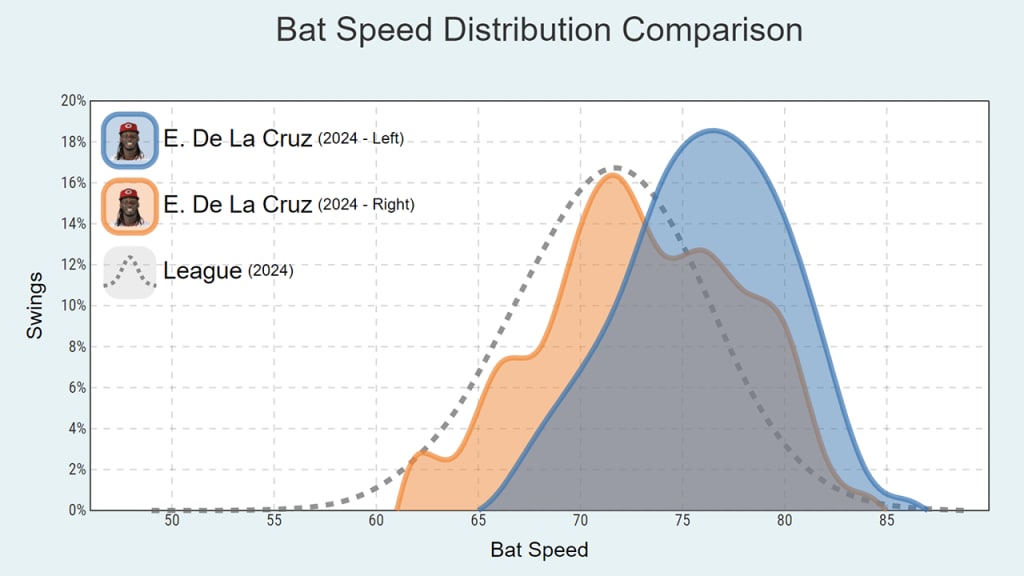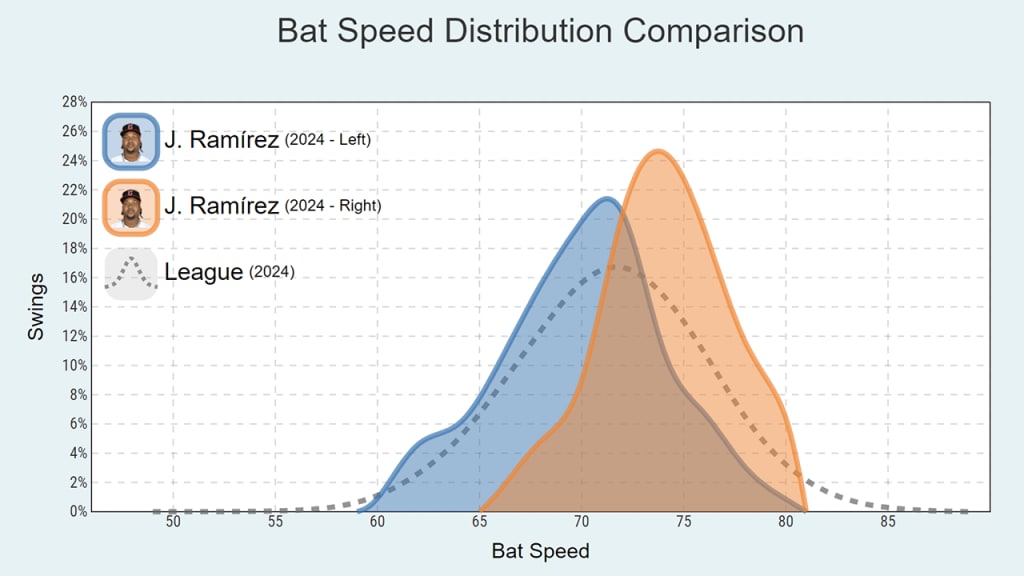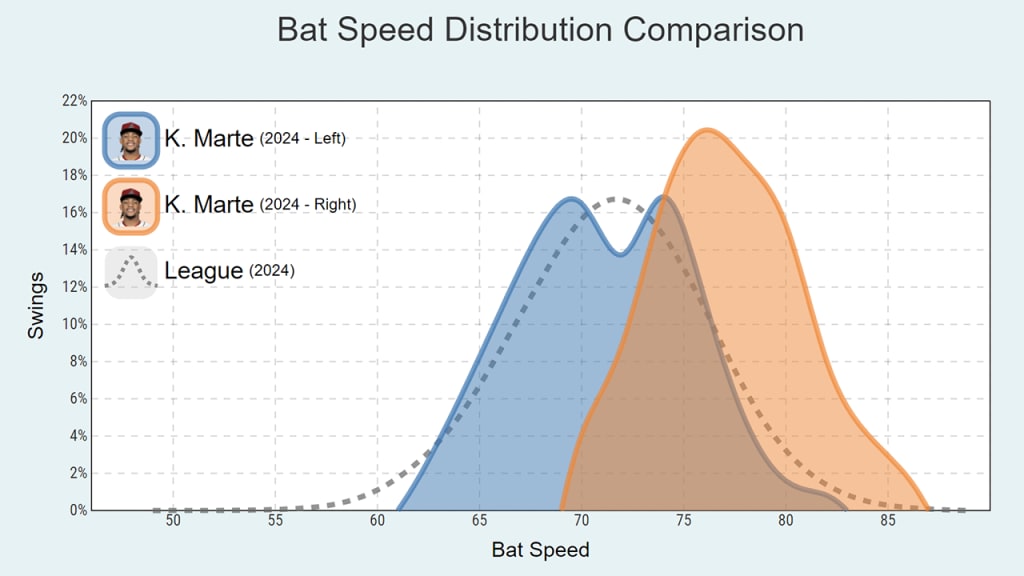As it turns out, there isn’t just one Elly De La Cruz. There are two.
As exciting as that must sound for Cincinnati fans – imagine adding another superstar Elly to an otherwise struggling lineup! – we’re not magically introducing another player to the Reds roster. Instead, let’s introduce you to Lefty De La Cruz and Righty De La Cruz. They’re extremely different.
Lefty De La Cruz – LDLC, if you’ll indulge us – is powerful, and patient, as befits a player with a career .493 slugging percentage and an .826 OPS. He has, to date, an outstanding 54% hard-hit rate, which would be a top-10 mark this year – similar to Bobby Witt Jr. He mashed in the Minors, too, posting a 1.012 OPS in his last full Minor League season in 2022.
Righty De La Cruz – RDLC – is a very different player. In his Major League career to date he’s hit just .209/.282/.294, for an OPS of merely .576. Going back to that 2022 Minor League season, it was the same. A .762 OPS might sound OK, but it was also 250 points lower than he had as a lefty batter. RDLC’s hard-hit rate of 30% is below average, somewhere around 230th with Elias Díaz and Brett Baty.
To simplify it by Statcast career run value: LDLC is +15, and RDLC is -7.
So far, we’ve hardly broken new ground. Platoon splits have been accessible for practically forever. But rather than just look at the outcomes of the two different Ellys De La Cruz, we can take a different look at how he’s getting there, with the newest in Statcast’s bat-tracking metrics. Why do LDLC and RDLC seem like two different hitters? Because they are.
Consider the most basic bat-tracking metric: bat speed. What does LDLC do? He swings hard – his average bat speed of 76 mph would place him just outside the top 10 hardest swingers, right in between Juan Soto and Yordan Alvarez, and his fast-swing rate (that’s swings above 75 mph) of 62% would rank 10th as well.
RDLC, meanwhile, swings a lot more softly; while 73 mph is still above-average, it’s considerably slower than his lefty counterpart; it would rate somewhere around Mickey Moniak and Jack Suwinski on the bat speed leaderboard. That fast-swing rate drops by half, to just 36%.
You can see in this overlay, which shows that LDLC (blue) is consistently in that 75-80 mph range, and remember, anything over 75 mph is that “fast swing.” But RDLC (orange) is a little more all over the place – sure, he can get up to the 80s when he needs to, but there are more fits and starts. The swings are less consistent, and far slower.

That’s fine, or at least it can be; as we explored with Luis Arraez’s incredible ability to endlessly square up baseballs despite the slowest bat speed in the game, there’s more than one way to be successful. If we were in fact seeing “Yordan Alvarez from one side and Luis Arraez from the other side,” not only would that be phenomenally interesting, it would make for an (even more) incredible hitter than the one we’re already seeing.
It’s not quite like that, though. RDLC chases more (31% to 25%) than his lefty counterpart; he hits more grounders too. His squared-up rate of 19% (per swing) is lower than Lefty’s 25%, too, all of which is fascinating given that De La Cruz has said he’s naturally a right-handed swinger and took up switch-hitting at around 8 years old.
When Lefty De La Cruz swings, he’s good at the top of the zone and inside. He’s great on pitches middle-out and middle-low. When Righty De La Cruz swings, he has a mild hot zone low and inside, but otherwise, pitchers can handle him most everywhere else.

If the outcomes are different, it’s because the inputs are different, too. Switch-hitting is hard, because it requires maintaining two different swings. We’ve always known that – “It’s hard,” San Diego switch-hitter Jurickson Profar recently told the Union-Tribune, adding that “I’m a really good hitter right-handed, [and] I think if I stayed right-handed I’d have a really good career.”
Now, we know exactly how different those swings are. In fact, let’s take a trio of important metrics – we’ll choose fast-swing rate, chase rate and ground-ball rate – and compare LDLC and RDLC to the rest of the sport to find some close comparables.
Lefty, as it turns out, compares well with Gunnar Henderson or Vladimir Guerrero Jr.. Righty brings back a name we’ve already mentioned: Baty, of the Mets, who is hitting just .228/.295/.316.
All of which made us think: Is this extreme? What other switch-hitters look like this? Do any?
So far in 2024, there are 28 batters who have taken at least 50 swings from both sides of the plate.
Two have an extremely consistent swing, in that they have less than 1 mph difference in bat speed from each side of the plate: Ozzie Albies and Brayan Rocchio. (We were surprised by Albies as well, given that he’s slugged 130 points higher as a RHB over the last two seasons, which goes to show that bat speed is an important thing, but it’s not the only thing.)
Eighteen more switch-hitters, for a total of 20, have a gap of no more than 2 mph in either direction – this group includes hitters such as Adley Rutschman, Francisco Lindor, Ian Happ and Profar.
That leaves us, then, with 11 hitters who have an extreme gap, which we’re defining as at least a 2 mph difference in bat speed between the two swings. That’s four who swing harder from the left side, and seven who swing harder from the right side.
These four hitters swing at least 2 MPH harder from the left side:
Josh Bell, Elly De La Cruz, Robbie Grossman, Keibert Ruiz
This group is a little all over the place. While De La Cruz is, as we noted, much better from the left side over the last two seasons, Ruiz has no appreciable handedness split in the same span. Bell has been better from the right side – his walk rate shoots up – and Grossman has been much better as a righty, despite the slower bat. (That would seem to be related to the fact that as a righty, his squared-up rate of 40% is superior to the 25% he’s getting from the left side.)
These six swing at least 2 mph harder from the right side:
Jeimer Candelario, Ketel Marte, Blake Perkins, José Ramírez, Luis Rengifo, Ildemaro Vargas
As it turns out, the 3 mph gap between LDLC and RDLC, while significant, is not the largest.
Ramírez swings a little harder as a righty …

… and Marte swings a LOT harder as a righty.

But Ramírez has an equal squared-up rate from either side. So does Marte. De La Cruz, however, does not.
If this all sounds as simple as “then they should just stop switch-hitting,” it’s not, or at least not for everyone. While Baltimore outfielder Cedric Mullins famously kick-started his career by deciding to go lefty-only prior to 2021, and the Braves have had conversations about it with Albies at times, it often comes down simply to comfort, not numbers. In the winter of 2022-23, Marte reported to winter ball in the Dominican Republic with the intention of dropping his lefty swing and going right-only.
“It was no good,” he told Nick Piecoro of the Arizona Republic. “No good for me.”
As it turned out, a lifetime of seeing right-handed pitchers from the lefty batter’s box made trying to identify right-handed breaking balls from the other side of the plate an incredibly difficult task. “[I think I learned] it’s too late to try [giving up switch-hitting],” he added. “If I was a little kid, yeah, one side might work. But, right now, no chance.”
As for Lefty De La Cruz and Righty De La Cruz, there’s no indication that either of them will disappear any time soon, and RDLC has indeed cut his strikeout rate down from last year’s 40% to this year’s 30%. (“I feel comfortable on both sides,” he said this spring.)
They might, however, be coming closer to the same person. After all, LDLC is swinging slightly softer in May, while RDLC is swinging a lot harder. On the other hand, De La Cruz has just a single homer this month, after mashing eight in April. What he does from the left side, it turns out, is a lot more important.


